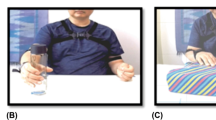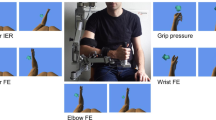Abstract
Purpose
Upper limb assessments in children with hemiparesis rely on clinical measurements, which despite standardization are prone to error. Recently, 3D movement analysis using optoelectronic setups has been used to measure upper limb movement, but generalization is hindered by time and cost. Body worn inertial sensors may provide a simple, cost-effective alternative.
Methods
We instrumented a subset of 30 participants in a mirror therapy clinical trial at baseline, post-treatment, and follow-up clinical assessments, with wireless inertial sensors positioned on the arms and trunk to monitor motion during reaching tasks.
Results
Inertial sensor measurements distinguished paretic and non-paretic limbs with significant differences (P < 0.01) in movement duration, power, range of angular velocity, elevation, and smoothness (normalized jerk index and spectral arc length). Inertial sensor measurements correlated with functional clinical tests (Melbourne Assessment 2); movement duration and complexity (Higuchi fractal dimension) showed moderate to strong negative correlations with clinical measures of amplitude, accuracy, and fluency.
Conclusion
Inertial sensor measurements reliably identify paresis and correlate with clinical measurements; they can therefore provide a complementary dimension of assessment in clinical practice and during clinical trials aimed at improving upper limb function.



Similar content being viewed by others
References
Hadoush H, Mano H, Sunagawa T, Nakanishi K, Ochi M (2013) Optimization of mirror therapy to excite ipsilateral primary motor cortex. NeuroRehabilitation 32:617–624
Gordon AM, Bleyenheuft Y, Steenbergen B (2013) Pathophysiology of impaired hand function in children with unilateral cerebral palsy. Dev Med Child Neurol 55(Suppl 4):32–37
Gilmore R, Sakzewski L, Boyd R (2010) Upper limb activity measures for 5- to 16-year-old children with congenital hemiplegia: a systematic review. Dev Med Child Neurol 52:14–21
Wallen M, Stewart K (2015) Upper limb function in everyday life of children with cerebral palsy: description and review of parent report measures. Disabil Rehabil 37:1353–1361
Petuskey K, Bagley A, Abdala E, James MA, Rab G (2007) Upper extremity kinematics during functional activities: three-dimensional studies in a normal pediatric population. Gait Posture 25:573–579
Butler EE, Ladd AL, Louie SA, Lamont LE, Wong W, Rose J (2010) Three-dimensional kinematics of the upper limb during a reach and grasp cycle for children. Gait Posture 32:72–77
Butler EE, Rose J (2012) The pediatric upper limb motion index and a temporal-spatial logistic regression: quantitative analysis of upper limb movement disorders during the reach & grasp cycle. J Biomech 45:945–951
Coluccini M, Maini ES, Martelloni C, Sgandurra G, Cioni G (2007) Kinematic characterization of functional reach to grasp in normal and in motor disabled children. Gait Posture 25:493–501
Fitoussi F, Diop A, Maurel N, Laasel el M, Ilharreborde B, Pennecot GF (2011) Upper limb motion analysis in children with hemiplegic cerebral palsy: proximal kinematic changes after distal botulinum toxin or surgical treatments. J Child Orthop 5:363–370
Jaspers E, Desloovere K, Bruyninckx H, Molenaers G, Klingels K, Feys H (2009) Review of quantitative measurements of upper limb movements in hemiplegic cerebral palsy. Gait Posture 30:395–404
Jaspers E, Feys H, Bruyninckx H, Cutti A, Harlaar J, Molenaers G et al (2011) The reliability of upper limb kinematics in children with hemiplegic cerebral palsy. Gait Posture 33:568–575
Mackey AH, Miller F, Walt SE, Waugh MC, Stott NS (2008) Use of three-dimensional kinematic analysis following upper limb botulinum toxin A for children with hemiplegia. Eur J Neurol 15:1191–1198
Mackey AH, Walt SE, Lobb GA, Stott NS (2005) Reliability of upper and lower limb three-dimensional kinematics in children with hemiplegia. Gait Posture 22:1–9
Reid S, Elliott C, Alderson J, Lloyd D, Elliott B (2010) Repeatability of upper limb kinematics for children with and without cerebral palsy. Gait Posture 32:10–17
Schneiberg S, McKinley P, Gisel E, Sveistrup H, Levin MF (2010) Reliability of kinematic measures of functional reaching in children with cerebral palsy. Dev Med Child Neurol 52:e167–e173
van der Heide JC, Fock JM, Otten B, Stremmelaar E, Hadders-Algra M (2005) Kinematic characteristics of reaching movements in preterm children with cerebral palsy. Pediatr Res 57:883–889
Petrarca M, Zanelli G, Patane F, Frascarelli F, Cappa P, Castelli E (2009) Reach-to-grasp interjoint coordination for moving object in children with hemiplegia. J Rehabil Med 41:995–100
Elliott C, Reid S, Hamer P, Alderson J, Elliott B (2011) Lycra((R)) arm splints improve movement fluency in children with cerebral palsy. Gait Posture 33:214–219
Preston N, Weightman A, Culmer P, Levesley M, Bhakta B, Mon-Williams M (2016) The Cerebral Palsy Kinematic Assessment Tool (CPKAT): feasibility testing of a new portable tool for the objective evaluation of upper limb kinematics in children with cerebral palsy in the non-laboratory setting. Disabil Rehabil Assist Technol 11:339–344
Brochard S, Lempereur M, Mao L, Remy-Neris O (2012) The role of the scapulo-thoracic and gleno-humeral joints in upper-limb motion in children with hemiplegic cerebral palsy. Clin Biomech (Bristol, Avon) 27:652–660
Franco de Moura RC, Almeida CS, Dumont AJ, Lazzari RD, Lopes JB, Duarte NA et al (2016) Kinematic upper limb evaluation of children and adolescents with cerebral palsy: a systematic review of the literature. J Phys Ther Sci 28:695–700
Wu G, van der Helm FCT, Veeger HEJ, Makhsous M, Van Roy P, Anglin C et al (2005) ISB recommendation on definitions of joint coordinate systems of various joints for the reporting of human joint motion—part II: shoulder, elbow, wrist and hand. J Biomech 38:981–992
Hailey D, Tomie J (2000) An assessment of gait analysis in the rehabilitation of children with walking difficulties. Disabil Rehabil 22:275–280
Simon SR (2004) Quantification of human motion: gait analysis-benefits and limitations to its application to clinical problems. J Biomech 37:1869–1880
Bai L, Pepper MG, Yan Y, Spurgeon SK, Sakel M, Phillips M (2015) Quantitative assessment of upper limb motion in neurorehabilitation utilizing inertial sensors. IEEE Trans Neural Syst Rehabil Eng 23:232–243
Bouvier B, Duprey S, Claudon L, Dumas R, Savescu A (2015) Upper limb kinematics using inertial and magnetic sensors: comparison of sensor-to-segment calibrations. Sensors (Basel) 15:18813–18833
van Meulen FB, Reenalda J, Buurke JH, Veltink PH (2015) Assessment of daily-life reaching performance after stroke. Ann Biomed Eng 43:478–486
Wang Q, Markopoulos P, Yu B, Chen W, Timmermans A (2017) Interactive wearable systems for upper body rehabilitation: a systematic review. J Neuroeng Rehabil 14:20
Bruchez R, Jequier Gygax M, Roches S, Fluss J, Jacquier D, Ballabeni P et al (2016) Mirror therapy in children with hemiparesis: a randomized observer-blinded trial. Dev Med Child Neurol
Coley B, Jolles BM, Farron A, Bourgeois A, Nussbaumer F, Pichonnaz C et al (2007) Outcome evaluation in shoulder surgery using 3D kinematics sensors. Gait Posture 25:523–532
Jaspers E, Feys H, Bruyninckx H, Harlaar J, Molenaers G, Desloovere K (2011) Upper limb kinematics: development and reliability of a clinical protocol for children. Gait Posture 33:279–285
Spirtos M, O’Mahony P, Malone J (2011) Interrater reliability of the Melbourne assessment of unilateral upper limb function for children with hemiplegic cerebral palsy. Am J Occup Ther 65:378–383
Najafi B, Aminian K, Paraschiv-Ionescu A, Loew F, Bula CJ, Robert P (2003) Ambulatory system for human motion analysis using a kinematic sensor: monitoring of daily physical activity in the elderly. IEEE Trans Biomed Eng 50:711–723
Duc C, Pichonnaz C, Bassin JP, Farron A, Jolles BM, Aminian K (2014) Evaluation of muscular activity duration in shoulders with rotator cuff tears using inertial sensors and electromyography. Physiol Meas 35:2389–2400
Duc C (2013) Objective outcome evaluation of the shoulder and cervical function after surgery using body-fixed sensors. Lausanne, Ecole Polytechnique Fédérale de Lausanne
Jolles BM, Duc C, Coley B, Aminian K, Pichonnaz C, Bassin JP et al (2011) Objective evaluation of shoulder function using body-fixed sensors: a new way to detect early treatment failures? J Shoulder Elb Surg 20:1074–1081
Hester T, Hughes R, Sherrill DM, Knorr B, Akay M, Stein J, et al. ( 2006) Using wearable sensors to measure motor abilities following stroke. International Workshop on Wearable and Implantable Body Sensor Networks (BSN'06); IEEE. p. 4 pp.-8
Balasubramanian S, Melendez-Calderon A, Burdet E (2012) A robust and sensitive metric for quantifying movement smoothness. IEEE Trans Biomed Eng 59:2126–2136
Higuchi T (1988) Approach to an irregular time series on the basis of the fractal theory. Physica D: Nonlinear Phenomena 31:277–283
Raghavendra B, Dutt DN (2009) A note on fractal dimensions of biomedical waveforms. Comput Biol Med 39:1006–1012
Elliott CM, Reid SL, Alderson JA, Elliott BC (2011) Lycra arm splints in conjunction with goal-directed training can improve movement in children with cerebral palsy. NeuroRehabilitation 28:47–54
Hung YC, Casertano L, Hillman A, Gordon AM (2011) The effect of intensive bimanual training on coordination of the hands in children with congenital hemiplegia. Res Dev Disabil 32:2724–2731
Schneiberg S, McKinley PA, Sveistrup H, Gisel E, Mayo NE, Levin MF (2010) The effectiveness of task-oriented intervention and trunk restraint on upper limb movement quality in children with cerebral palsy. Dev Med Child Neurol 52:e245–e253
Klotz MC, van Drongelen S, Rettig O, Wenger P, Gantz S, Dreher T et al (2014) Motion analysis of the upper extremity in children with unilateral cerebral palsy—an assessment of six daily tasks. Res Dev Disabil 35:2950–2957
Biswas D, Cranny A, Gupta N, Maharatna K, Achner J, Klemke J et al (2015) Recognizing upper limb movements with wrist worn inertial sensors using k-means clustering classification. Hum Mov Sci 40:59–76
Leuenberger K, Gonzenbach R, Wachter S, Luft A, Gassert R (2017) A method to qualitatively assess arm use in stroke survivors in the home environment. Med Biol Eng Comput 55:141–150
Funding
This study was supported by grants from the Swiss National Science Foundation (Bern, CH, grant no. 32003B_141167/1) and Fondation Pierre Mercier pour la Science (Lausanne, CH). The funding sponsors had no role in the design of the study; in the collection, analyses, or interpretation of data; in the writing of the manuscript; and in the decision to publish the results.
Author information
Authors and Affiliations
Corresponding author
Ethics declarations
Conflict of interest
Christopher J. Newman and Kamiar Aminian are shareholders of Gait Up SA. The other authors declare no conflict of interest.
Rights and permissions
About this article
Cite this article
Newman, C.J., Bruchez, R., Roches, S. et al. Measuring upper limb function in children with hemiparesis with 3D inertial sensors. Childs Nerv Syst 33, 2159–2168 (2017). https://doi.org/10.1007/s00381-017-3580-1
Received:
Accepted:
Published:
Issue Date:
DOI: https://doi.org/10.1007/s00381-017-3580-1




